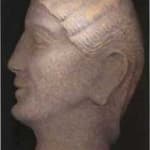Etruscan Terracotta Profile Head Relief of a Woman, 1 Century BCE
Terracotta
12.25
X.0048
Our knowledge about the Etruscan civilization is extremely limited. Our understanding of their language is still incomplete and most of the information that is known comes to us through the...
Our knowledge about the Etruscan civilization is extremely limited. Our understanding of their language is still incomplete and most of the information that is known comes to us through the Romans, their one time subjects who grew to become their masters. The Etruscans lived under a series of autonomous city-states spread out across northern and central Italy. By the 3rd Century B.C., they would be absorbed into the burgeoning Roman Empire. In Etruria from the earliest times, cinerary urns were engraved with images of a human face, perhaps intended to be the portrait of the deceased whose ashes were contained within. Later, sculpted masks served as the covers of the urns. Eventually, as the style evolved, the urns themselves were sculpted in the shaped of human faces. Some of the most splendid examples of Etruscan funerary art were excavated from the necropolis of Chiusi, one of the large population centers of Etruria. Whether this portrait head of a woman served as a cinerary urn or decorated one is unknown. However, it is clearly concerned with the funerary rites and no doubt yearned to capture the essence of this woman’s physical being for all eternity. And in this way, the artist was successful. Here we are, more than two thousand years later, confronted by a person who does not seem so distant from us. We recognize ourselves in her face, in her wavy hair and gentle smile.



